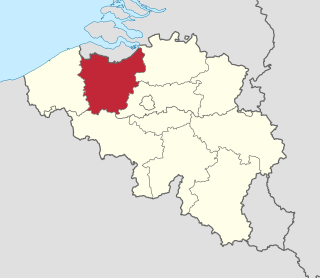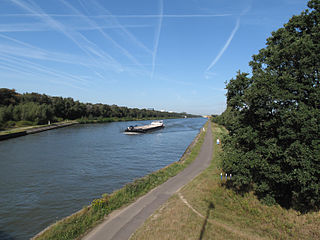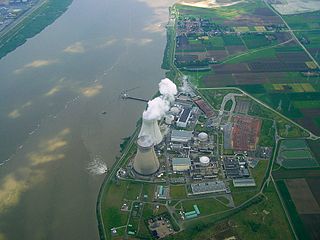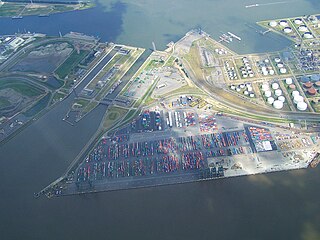
Transport in Belgium is facilitated with well-developed road, air, rail and water networks. The rail network has 2,950 km (1,830 mi) of electrified tracks. There are 118,414 km (73,579 mi) of roads, among which there are 1,747 km (1,086 mi) of motorways, 13,892 km (8,632 mi) of main roads and 102,775 km (63,861 mi) of other paved roads. There is also a well-developed urban rail network in Brussels, Antwerp, Ghent and Charleroi. The ports of Antwerp and Bruges-Zeebrugge are two of the biggest seaports in Europe. Brussels Airport is Belgium's biggest airport.

Flanders is the Dutch-speaking northern portion of Belgium and one of the communities, regions and language areas of Belgium. However, there are several overlapping definitions, including ones related to culture, language, politics, and history, and sometimes involving neighbouring countries. The demonym associated with Flanders is Fleming, while the corresponding adjective is Flemish, which is also the name of the local dialect. The official capital of Flanders is the City of Brussels, although the Brussels-Capital Region that includes it has an independent regional government. The powers of the government of Flanders consist, among others, of economic affairs in the Flemish Region and the community aspects of Flanders life in Brussels, such as Flemish culture and education.

The Scheldt is a 435-kilometre-long (270 mi) river that flows through northern France, western Belgium, and the southwestern part of the Netherlands, with its mouth at the North Sea. Its name is derived from an adjective corresponding to Old English sceald ("shallow"), Modern English shoal, Low German schol, West Frisian skol, and obsolete Swedish skäll ("thin").

East Flanders is a province of Belgium. It borders the Dutch province of Zeeland and the Flemish province of Antwerp, Flemish Brabant, Hainaut and West Flanders. It has an area of 3,007 km2 (1,161 sq mi), divided into six administrative districts containing 60 municipalities, and a population of 1,515,064 as of January 2019. The capital is Ghent, home to the Ghent University and the Port of Ghent.

The Western Scheldt in the province of Zeeland in the southwestern Netherlands, is the estuary of the Scheldt river. This river once had several estuaries, but the others are now disconnected from the Scheldt, leaving the Westerschelde as its only direct route to the sea. The Western Scheldt is an important shipping route to the Port of Antwerp, Belgium. Unlike the Eastern Scheldt estuary, it could not be closed off from the sea by a dam as part of the Delta Works. Instead, the dykes around it have been heightened and reinforced.

Beveren is a municipality in the Belgian province of East Flanders which comprises the towns of Beveren, Doel, Haasdonk, Kallo, Kieldrecht, Melsele, Verrebroek and Vrasene.

Zwijndrecht is both a village and a municipality located in the Flemish province of Antwerp, in Belgium. As well as Zwijndrecht proper, the municipality includes the village of Burcht. In 2021, Zwijndrecht had a total population of 19,263.

Panamax and New Panamax are terms for the size limits for ships travelling through the Panama Canal. The limits and requirements are published by the Panama Canal Authority (ACP) in a publication titled "Vessel Requirements". These requirements also describe topics like exceptional dry seasonal limits, propulsion, communications, and detailed ship design.

The Albert Canal is a canal located in northeastern Belgium, which was named for King Albert I of Belgium. The Albert Canal connects Antwerp with Liège, and also the Meuse river with the Scheldt river. It also connects with the Dessel–Turnhout–Schoten Canal, and its total length is 129.5 kilometres (80.5 mi).

The Port of Antwerp is the port of the city of Antwerp, Belgium. It is located in Flanders, mainly in the province of Antwerp, but also partially in East Flanders. It is a seaport in the heart of Europe accessible to capesize ships. It is Europe's second-largest seaport, after that of Rotterdam. Antwerp stands at the upper end of the tidal estuary of the Scheldt. The estuary is navigable by ships of more than 100,000 Gross Tons as far as 80 km inland. Like the Port of Hamburg, the Port of Antwerp's inland location provides a more central location in Europe than the majority of North Sea ports. Antwerp's docks are connected to the hinterland by rail, road, and river and canal waterways. As a result, the port of Antwerp has become one of Europe's largest seaports, ranking second behind Rotterdam by total freight shipped. Its international rankings vary from 11th to 20th (AAPA). In 2012, the Port of Antwerp handled 14,220 sea trade ships, 57,044 inland barges, and offered liner services to 800 different maritime destinations.

The Port of Rotterdam is the largest seaport in Europe, and the world's largest seaport outside of East Asia, located in and near the city of Rotterdam, in the province of South Holland in the Netherlands. From 1962 until 2004, it was the world's busiest port by annual cargo tonnage. It was overtaken first in 2004 by the port of Singapore, and since then by Shanghai and other very large Chinese seaports. In 2020, Rotterdam was the world's tenth-largest container port in terms of twenty-foot equivalent units (TEU) handled. In 2017, Rotterdam was also the world's tenth-largest cargo port in terms of annual cargo tonnage.

Doel is a subdivision of the municipality of Beveren in the Flemish province of East Flanders in Belgium. It is located near the river the Scheldt, in a polder of the Waasland. Since 1965, there have been plans to extend the Port of Antwerp into Doel and demolish the village. However, protests have caused a stalemate. On 30 March 2022, a deal was reached and the village is allowed to exist.

The Brussels–Scheldt Maritime Canal, also known as the Willebroek Canal amongst other similar names, is an important canal in Belgium. The 28-kilometre-long (17 mi) canal has a width of 30 metres (98 ft) and a draught of 2 metres, and connects Brussels with the Scheldt river at Wintam and ultimately the sea.

The Doel Nuclear Power Station is one of two nuclear power plants in Belgium. The plant includes four reactors. The site is located on the bank of the Scheldt river, near the village of Doel in the Flemish province of East Flanders, on the outskirts of the city of Antwerp. The station is operated and majority-owned by vertically-integrated French energy corporation Engie SA through its 100%-owned Belgian subsidiary Electrabel. EDF Luminus has a 10.2% stake in the two newest units. The Doel plant employs 963 workers and covers an area of 80 hectares. The plant represents about 15% of Belgium's total electricity production capacity and 30% of the total electricity generation. Nuclear energy typically provides half of Belgium's domestically-generated electricity and is the country's lowest-cost source of power.

Antwerp is the largest city in Belgium by area at 204.51 km2 (78.96 sq mi) and the capital of Antwerp Province in the Flemish Region. With a population of 536,079, it is the most populous municipality in Belgium, and with a metropolitan population of around 1,200,000 people, it is the second-largest metropolitan region in Belgium, second only to Brussels.

The Berendrecht Lock is the world's second-largest lock, providing access to the right-bank docks of the Port of Antwerp in Belgium.

Kieldrecht is a village and deelgemeente (sub-municipality) of Beveren in East Flanders, Belgium. Kieldrecht was an independent municipality until 1977, when it merged with Beveren as part of the fusion of municipalities in Belgium. The village is located on the border with the Netherlands, and forms a single urban area with the Dutch village of Nieuw-Namen.
The following is a timeline of the history of the municipality of Antwerp, Belgium.

The Royers lock is a tidal lock located in Belgium, giving access to the right bank docks in the Port of Antwerp and the Albert Canal. Although it was built for sea-going vessels, it is now mostly used by riverboats.

The Port Authority Building, or the Port House, is a government building located in Antwerp, Belgium, built between 2009 and 2016. It is located in the area of Eilandje, in the Port of Antwerp, and acts as the new headquarters of the Antwerp Port Authority, housing various departments. Designed by Iraqi-British architect Zaha Hadid, the building opened in 2016, the year of her death. It is the sole government building designed by Hadid. The design of the building incorporates the use of a fire station, integrating it into the building. Attached above and connected to the fire station is a contemporary diamond-shaped structure marked by straight edges, with an additional column providing support from the floor.





















